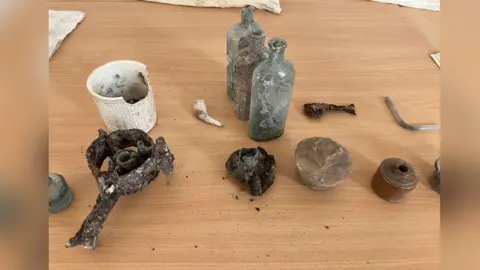College's secrets emerge 140 years after fatal fire
 Aberystwyth University Archive
Aberystwyth University ArchiveArchaeologists have uncovered surviving features of a Victorian university building almost 140 years after it was gutted by a fire which killed three people.
Charred wood, blackened walls and laboratory equipment have been revealed by work to renovate Aberystwyth’s Grade I listed Old College building.
The £43m restoration project aims to give new life to the building, which will become a centre for learning, heritage, culture and enterprise, and include a four-star hotel.
Once complete, it is expected to attract 200,000 visitors a year and contribute up to £14.5m annually to the local economy.

Part of the renovation involves digging down into the building’s basement where archaeologists have found remnants of the devastating fire which started in a chemistry laboratory.
Pieces of charred wood have been found in the rubble as well as a damaged Bunsen burner, a small stove and a number of glass bottles.
At the time of the fire – 8 July 1885 – the Old College included a number of academic departments, a library, museum and living quarters.
Spontaneous combustion
In a report, the local paper the Cambrian News and Meirionethshire Standard described the fire’s devastating effects.
It said how a Mr Stone, "headmaster of the collegiate school," was standing on the "terrace in front of the college when the chimney which crushed the museum fell", causing him to jump on to the beach below.
It’s believed the fire started on the fifth floor and, according to the newspaper report, an investigation was carried out by Colonel Sir Charles Firth, president of the Fire Brigade Association in London.
The report says he concluded "the cause of the fire was spontaneous combustion amongst the cotton waste used in cleaning up after the chemical experiments in the laboratory department".
It’s believed the fire caused oxygen cylinders in the laboratory to explode.
Elgan Davies, who worked as a librarian in the Old College, has written about the building's history.
He said the fire was "very bad, not only physically in burning the building" but also because three men died.
On the night of the fire, local people – who had helped raise the money to set up the university in 1872 – went into the burning building to try to save valuables, according to Mr Davies.
"Efforts were made to save treasures from the library and the museum and those were brought out," he said.
"But there was still three people inside fighting the fire in the museum when the floor gave way. They fell through to the floor below, and were terribly burned and died."
The men who were killed were James Edwin Brett, who was 21 and lived with his mother, Samuel Jones, who was married with two children, and John Davies, who was married with six children.

Faye Thompson, the collections co-ordinator for the Old College project, said the men had no direct link with the university, but their actions were still appreciated today.
“[Their bravery] enabled us to save the entirety of the library collections, and a lot of the museum pieces too," she said.
"We have some pieces now in our collection that we can display again because they survived the fire due to the efforts of these men and others as well."
The funerals of the three men who died were attended by local dignitaries and more than 2,000 people.
Piecing together the building's story
Now, almost 140 years after the fire, evidence of its effects has come to light as the current renovation work continues.
Jessica Domiczew, from Welsh archaeology trust Heneb, said her team are "piecing together the building’s story bit by bit" after archaeologists working with building contractors found objects from the time of the fire hidden in rubble.
"Throughout the excavation we've had a few pieces of wood which [are] quite heavily burned, dotted throughout the gallery. There's a very good chance that it's connected to the fire [but] we don't have any real other explanation of where it's from," she said.
"It's very exciting as an archaeologist - we don't really get so many well-intact artefacts like this."

Aberystwyth University was still a young institution at the time of the fire, opening its doors just 13 years earlier in 1872.
After the blaze, there were suggestions that the idea of maintaining a university in Aberystwyth should be abandoned and funding diverted to set up a new institution in Swansea.
But, the Old College was rebuilt - paid for by £10,000 of insurance money and thousands more raised by ordinary people from across Wales and beyond.
The current renovation project is respectful of the building’s history and heritage while also giving it a future for generations to come, said project manager Jim O’Rourke, who added that first electric light and the first telephone in Aberystwyth were both installed in the Old College.
"The Old College has been at the forefront of changes but we now need to make it suitable for current expectations in terms of access, and how it develops to use modern technologies, as well as telling the story of the historic spaces we have here," he said.
